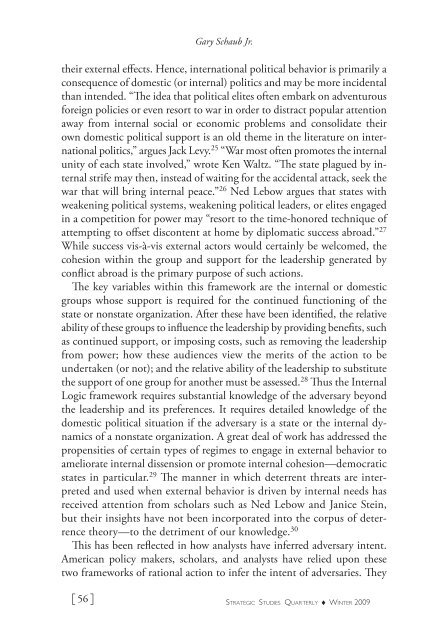When Is Deterrence Necessary? Gauging Adversary Intent
When Is Deterrence Necessary? Gauging Adversary Intent
When Is Deterrence Necessary? Gauging Adversary Intent
Create successful ePaper yourself
Turn your PDF publications into a flip-book with our unique Google optimized e-Paper software.
Gary Schaub Jr.<br />
their external effects. Hence, international political behavior is primarily a<br />
consequence of domestic (or internal) politics and may be more incidental<br />
than intended. “The idea that political elites often embark on adventurous<br />
foreign policies or even resort to war in order to distract popular attention<br />
away from internal social or economic problems and consolidate their<br />
own domestic political support is an old theme in the literature on international<br />
politics,” argues Jack Levy. 25 “War most often promotes the internal<br />
unity of each state involved,” wrote Ken Waltz. “The state plagued by internal<br />
strife may then, instead of waiting for the accidental attack, seek the<br />
war that will bring internal peace.” 26 Ned Lebow argues that states with<br />
weakening political systems, weakening political leaders, or elites engaged<br />
in a competition for power may “resort to the time-honored technique of<br />
attempting to offset discontent at home by diplomatic success abroad.” 27<br />
While success vis-à-vis external actors would certainly be welcomed, the<br />
cohesion within the group and support for the leadership generated by<br />
conflict abroad is the primary purpose of such actions.<br />
The key variables within this framework are the internal or domestic<br />
groups whose support is required for the continued functioning of the<br />
state or nonstate organization. After these have been identified, the relative<br />
ability of these groups to influence the leadership by providing benefits, such<br />
as continued support, or imposing costs, such as removing the leadership<br />
from power; how these audiences view the merits of the action to be<br />
undertaken (or not); and the relative ability of the leadership to substitute<br />
the support of one group for another must be assessed. 28 Thus the Internal<br />
Logic framework requires substantial knowledge of the adversary beyond<br />
the leadership and its preferences. It requires detailed knowledge of the<br />
domestic political situation if the adversary is a state or the internal dynamics<br />
of a nonstate organization. A great deal of work has addressed the<br />
propensities of certain types of regimes to engage in external behavior to<br />
ameliorate internal dissension or promote internal cohesion—democratic<br />
states in particular. 29 The manner in which deterrent threats are interpreted<br />
and used when external behavior is driven by internal needs has<br />
received attention from scholars such as Ned Lebow and Janice Stein,<br />
but their insights have not been incorporated into the corpus of deterrence<br />
theory—to the detriment of our knowledge. 30<br />
This has been reflected in how analysts have inferred adversary intent.<br />
American policy makers, scholars, and analysts have relied upon these<br />
two frameworks of rational action to infer the intent of adversaries. They<br />
[ 56 ]<br />
Strategic Studies Quarterly ♦ Winter 2009
















